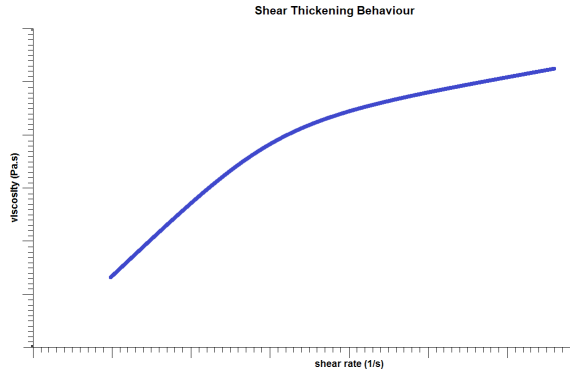Some Rheology Definitions
There are several rheological terms and concepts which commonly occur when describing the rheological behaviour of a system. The following are a few useful concepts, which are included here to be illustrative rather than mathematically precise.
Shear stress
Shear stress is related to the applied force (actually the force per unit area), which could be from stirring or otherwise disturbing the system.
Shear strain
Shear strain describes the change of movement during the applied shear stress. For a stirred slurry, shear strain is related to the speed of stirring.
Shear rate
This usually means the shear strain. For example, it can relate to the rotational speed of an impellor in a stirred slurry.
Shear thinning
A system which becomes lower in apparent viscosity when sufficiently disturbed, such as by stirring or shaking.

Shear thickening
A system which becomes higher in apparent viscosity when sufficiently disturbed, such as by stirring or shaking.

Storage modulus
This is the part of the shear stress energy which is retained and then released, usually by returning the system closer to its original state. The storage modulus of a mud is the elasticity or solid-like behaviour of the mud, and in rheological terms is given as G'.
Loss modulus
Loss modulus is the part of the shear stress energy which is lost, for example through friction. The loss modulus of a mud is the viscosity or liquid-like behaviour of the mud, and in rheological terms is given as G".
Thixotropic
Thixotropic substances exhibit shear thinning and take time to re-thicken after the shear thinning occurs.
Rheopectic
Rheopectic systems show an increase in viscosity with time while under the influence of shear stress.
Dilatant
Dilatant systems exhibit increasing viscosity with applied shear stress. Wet beach sand near the water shows dilatancy because it becomes firmer when walking on it.
Plastic or Bingham plastic behaviour
An ideal Bingham plastic has a clear yield point and then linear Newtonian behaviour, i.e. a constant viscosity with increasing shear stress.
Pseudoplastic
Pseudoplastic behaviour is shear thinning, typically with a poorly defined yield point.
Yield Stress
The stress required to make a sample start to significantly move or flow.


Share this post